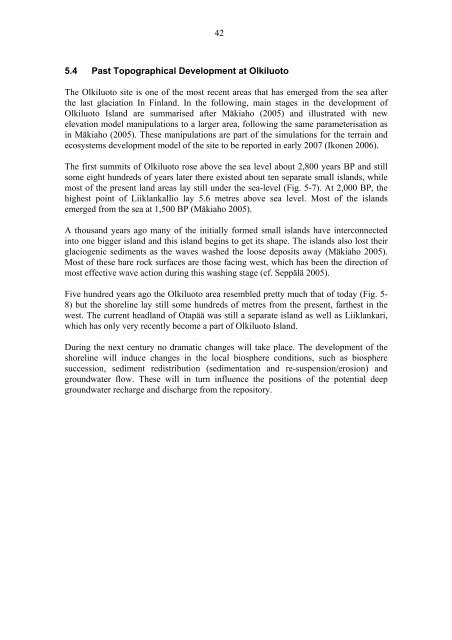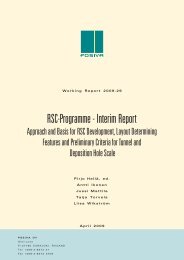Olkiluoto Biosphere Description 2006 (pdf) (4.1 MB) - Posiva
Olkiluoto Biosphere Description 2006 (pdf) (4.1 MB) - Posiva
Olkiluoto Biosphere Description 2006 (pdf) (4.1 MB) - Posiva
Create successful ePaper yourself
Turn your PDF publications into a flip-book with our unique Google optimized e-Paper software.
425.4 Past Topographical Development at <strong>Olkiluoto</strong>The <strong>Olkiluoto</strong> site is one of the most recent areas that has emerged from the sea afterthe last glaciation In Finland. In the following, main stages in the development of<strong>Olkiluoto</strong> Island are summarised after Mäkiaho (2005) and illustrated with newelevation model manipulations to a larger area, following the same parameterisation asin Mäkiaho (2005). These manipulations are part of the simulations for the terrain andecosystems development model of the site to be reported in early 2007 (Ikonen <strong>2006</strong>).The first summits of <strong>Olkiluoto</strong> rose above the sea level about 2,800 years BP and stillsome eight hundreds of years later there existed about ten separate small islands, whilemost of the present land areas lay still under the sea-level (Fig. 5-7). At 2,000 BP, thehighest point of Liiklankallio lay 5.6 metres above sea level. Most of the islandsemerged from the sea at 1,500 BP (Mäkiaho 2005).A thousand years ago many of the initially formed small islands have interconnectedinto one bigger island and this island begins to get its shape. The islands also lost theirglaciogenic sediments as the waves washed the loose deposits away (Mäkiaho 2005).Most of these bare rock surfaces are those facing west, which has been the direction ofmost effective wave action during this washing stage (cf. Seppälä 2005).Five hundred years ago the <strong>Olkiluoto</strong> area resembled pretty much that of today (Fig. 5-8) but the shoreline lay still some hundreds of metres from the present, farthest in thewest. The current headland of Otapää was still a separate island as well as Liiklankari,which has only very recently become a part of <strong>Olkiluoto</strong> Island.During the next century no dramatic changes will take place. The development of theshoreline will induce changes in the local biosphere conditions, such as biospheresuccession, sediment redistribution (sedimentation and re-suspension/erosion) andgroundwater flow. These will in turn influence the positions of the potential deepgroundwater recharge and discharge from the repository.
















